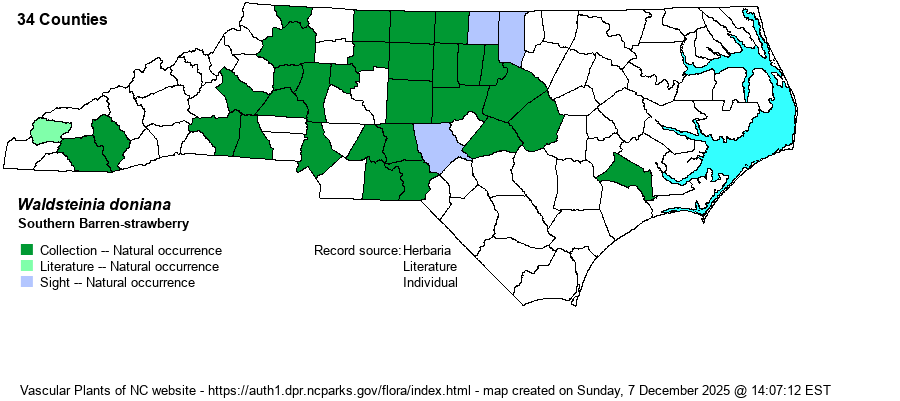| Author | Trattinick | |
| Distribution | The old Waldsteinia fragarioides has been recently split by some references into two species; the more northern one still retaining the name of W. fragarioides, with the southern form being named as either F. doniana (as in Weakley 2020) or as F. parviflora (as in Flora of North America) and adopted by NatureServe. These references indicate that the split out fragarioides ranges south to NC, and that doniana/parviflora ranges both north and south of NC and is almost certainly the more widespread one in the state. However, one website editor (Sorrie), as well as some other websites (e.g., Digital Atlas of the Virginia Flora), feel strongly that few specimens can be reliably separated into the two species; in fact, the SERNEC listing shows that nearly all herbaria have not attempted to separate out their specimens, if even possible to do so! (SERNEC in 2025 still shows only four county records for W. doniana, clearly showing that herbaria have not teased out this taxon as yet.) As a result, the editors have decided to put all records for these two (combined) onto the W. doniana map (see below), for the time being. Sadly, there is little detailed geographic information (in text form or on other maps) to show where these two forms overlap in NC, if anywhere.
This "new" species occurs from VA and TN south to GA and AL, according to Weakley (2020).
| |
| Abundance | Generally uncommon to at least locally infrequent across the Piedmont, but rare to possibly absent in the extreme northeastern portions. Very rare in the Mountains, as well as in the Coastal Plain. Status in the Mountains is complicated by the potential presence ofW. fragarioides there. The website editors suggest that a State Rank of S3 is more appropriate than S2S3, as assigned by NCNHP. NatureServe gives its Global Rank as G3G5. | |
| Habitat | This is a species of usually moist, but often rocky, sites. It grows on forested stream banks, on shaded cliffs and bluffs, rocky woods, and less so in rich soil away from rocks. |
| Phenology | Blooms from late March into May; fruits from May to June. | |
| Identification | This is a low species with evergreen leaves, barely reaching 1 foot long or tall. The several leaves are basal, on petioles about 2 inches long, and three-parted, cut to the base. Each leaflet is wedge-shaped or fan-shaped, about 1-1.2 inches long and across, toothed or scalloped on the margins (often incised), and quite shiny; they turn bronze in color in winter. The often several flower stalks are leafless, about 4-5 inches tall, and contain a few flowers at the tips. Each flower is bright yellow, with 5 petals that are somewhat elliptical, and the spread flower is about 1/3-inch across. The sepals are about as long as the petals. In the other similar species -- W. fragarioides -- the petals are 4-10 mm long, and longer than the sepals, as opposed to only 2.5-4 mm long in W. doniana; thus, the spread flower in that species is close to 3/4-inch across. This species is more easily found in winter or very early spring, as its shiny, evergreen leaves on a rocky slope are quite easily spotted. | |
| Taxonomic Comments | See above. This species (taxon) is now the southern portion of the original range of W. fragarioides. Weakley (2020) moved the three Waldsteinia species to Geum at that time but has since moved them back to Waldsteinia. The Flora of North America website names this taxon as W. parviflora. There is certainly concern that such a split of the original fragarioides into two full species (instead of designating them as subspecies or varieties, if even that) is not convincing.
| |
| Other Common Name(s) | Small-petaled Barren-strawberry (name used for W. parviflora) | |
| State Rank | S2S3 [S3] | |
| Global Rank | G3G5 | |
| State Status | | |
| US Status | | |
| USACE-agcp | | |
| USACE-emp | | |

